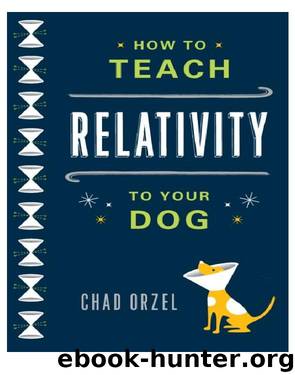How to Teach Relativity to Your Dog by Chad Orzel

Author:Chad Orzel
Language: eng
Format: epub
Publisher: Basic Books
Published: 2012-01-24T16:00:00+00:00
“So, there are particles out there with masses of trillions of electron volts? Wow.”
“There may be particles with masses on that scale, but we haven’t detected any yet. The heaviest known particles have masses in the 100 billion electron volt (GeV) range.”
“They do? Isn’t the LHC kind of excessive, then?”
“What do you mean?”
“Well, you need a few hundred GeV to produce a top quark and an antitop quark from energy, right? But your accelerator collides particles at 7,000 GeV. Isn’t that way more than you need?”
“It’s more total energy than you absolutely need, but total energy isn’t the only thing involved. Just because two colliding particles have 7,000 GeV of energy doesn’t mean that you’ll get anywhere near 7,000 GeV/c2 of new particles out. It’s actually pretty unlikely.”
“How unlikely?”
“Well, the LHC produces about 800 million collisions between protons every second. Only about two of those collisions produce a top and antitop quark with a combined mass of about 350 GeV/c2. So it’s something like a 1 in 400 million chance that you get even 5 percent of the energy you put in out as new particles.”
“That’s pretty unlikely. Why is that?”
“Well, because collisions of real particles are complicated. You can get a sense of this by thinking about playing pool. If you hit the cue ball straight into a stationary ball, the cue ball will stop, and the other ball will take off at the speed the cue ball had coming in. That’s a collision where all of the energy of the incoming particle got transferred to the target, right?”
“Of course.”
“That’s not the only kind of collision you get even in pool, though. If you hit a cut shot, striking the target ball at an angle, the cue ball continues moving after the collision. That’s a collision where only some of the cue ball’s energy got transferred to the target. And there are a lot more ways to do that than there are ways to hit targets so the cue ball comes to a perfect stop.”
“Okay. So the problem is that you keep running the protons into each other at a glancing angle?”
“That’s not it exactly, but it gives you the basic idea. And the situation for a collider using protons is even more complicated, because each proton consists of three quarks. So, in order to get absolutely all of the energy out, not only would you need to get the two protons to hit exactly head-on, but you would also need each of the quarks inside the two protons to hit head-on too. Since we can’t see the protons, let alone inside them, to aim precisely, it’s basically just a matter of luck.”
“So, what, you just throw lots of them together and hope a few will get you what you need?”
“Pretty much. You can avoid some of the problem by colliding particles that are really fundamental and not made up of anything else. The previous collider at CERN used electrons and positrons, and when those collide, you really do get all of the collision energy out as new stuff.
Download
This site does not store any files on its server. We only index and link to content provided by other sites. Please contact the content providers to delete copyright contents if any and email us, we'll remove relevant links or contents immediately.
The Complete Stick Figure Physics Tutorials by Allen Sarah(7338)
Secrets of Antigravity Propulsion: Tesla, UFOs, and Classified Aerospace Technology by Ph.D. Paul A. Laviolette(5333)
Thing Explainer by Randall Munroe(3910)
The River of Consciousness by Oliver Sacks(3572)
The Order of Time by Carlo Rovelli(3162)
How To by Randall Munroe(3074)
A Brief History of Time by Stephen Hawking(2992)
I Live in the Future & Here's How It Works by Nick Bilton(2960)
What If?: Serious Scientific Answers to Absurd Hypothetical Questions by Randall Munroe(2668)
The Great Unknown by Marcus du Sautoy(2662)
Midnight in Chernobyl by Adam Higginbotham(2516)
Blockchain: Ultimate Step By Step Guide To Understanding Blockchain Technology, Bitcoin Creation, and the future of Money (Novice to Expert) by Keizer Söze(2467)
Networks: An Introduction by Newman Mark(2382)
The Meaning of it All by Richard Feynman(2319)
Easy Electronics by Charles Platt(2308)
The Tao of Physics by Fritjof Capra(2247)
Midnight in Chernobyl: The Untold Story of the World's Greatest Nuclear Disaster by Adam Higginbotham(2196)
When by Daniel H Pink(2098)
Introducing Relativity by Bruce Bassett(2097)
